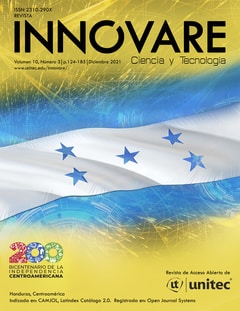El testamento de Francisco Morazán desde la caracterización discursiva de la lengua
DOI:
https://doi.org/10.5377/innovare.v10i3.12980Palabras clave:
Discurso, Francisco Morazán, Gramática del texto, Pragmática, TestamentoResumen
Introducción. El testamento de Francisco Morazán constituye una pieza documental de preciado valor cultural para la historiografía centroamericana. El objetivo de esta investigación fue analizar el espacio de interlocución utilizado por el prócer a través de las palabras y frases, siguiendo el análisis de los aspectos lingüísticos y literarios en los que se enmarca este discurso. Métodos. Investigación de paradigma cualitativo, fenomenológico, con enfoque discursivo. Asimismo, desde el enfoque semántico-comunicativo y pragmático se analizaron los espacios narrativos como referencias temporales y situacionales desde la percepción del emisor. Resultados. El texto sigue un orden discursivo en completa armonía léxica y referencial, también, las propiedades textuales evidencian “el yo” en consonancia con la situación pragmática. Esquemáticamente se puede indicar una conexión directa entre el emisor y los destinatarios; el autor se constituye en el único narrador de los hechos evocados al final de sus días. Conclusión. Las implicaciones de las propiedades textuales, retóricas, semánticas y pragmáticas revitalizan el mensaje, además, se constata cómo el General Morazán no solo hace acopio de su historia de vida, sino también de una cronología de espacios políticos que detallan, a través de los elementos textuales, el panorama de la Federación Centroamericana y el final que le espera con la muerte del prócer.
Descargas
4067
Publicado
Cómo citar
Número
Sección
Licencia
Derechos de autor 2021 Águeda Chávez, Miguel Barahona

Esta obra está bajo una licencia internacional Creative Commons Atribución-NoComercial-SinDerivadas 4.0.




